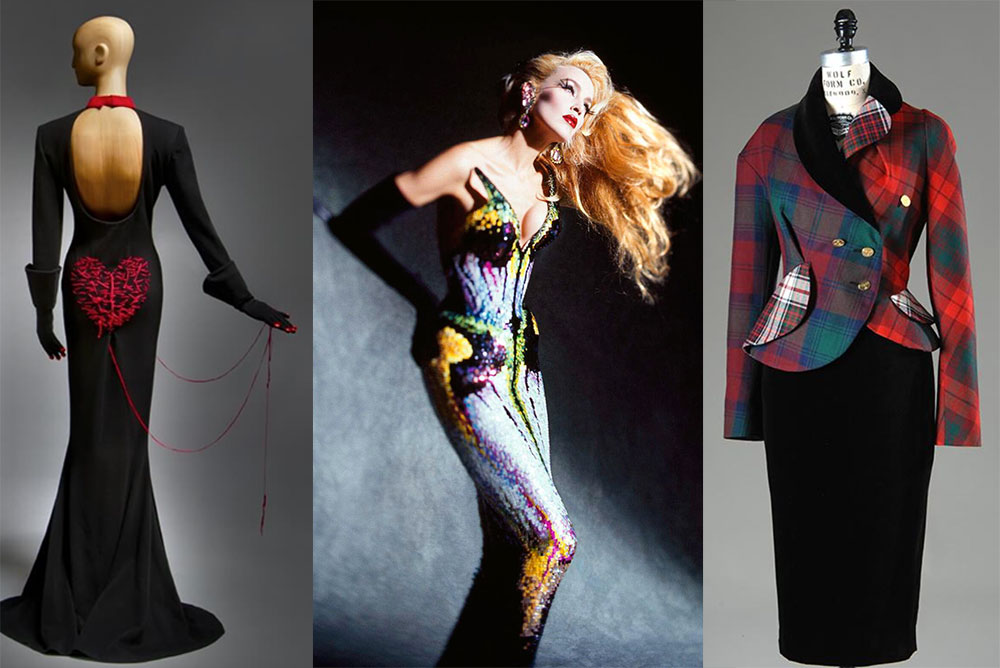
By Janet Kelly
KNOCK WOOD, fingers crossed, the world is opening up, and we’ll be able to travel again—keinehora—as my Jewish grandmother, if she were around, would say. In the fervent hope of that happening, we looked —from the East Coast to the West and across the pond—and found six museums with current fashion exhibits and another that will start in May. The designs of marquee names, including Yves Saint Laurent, Vivienne Westwood, Thierry Mugler, Martin Margiela, Franco Moschino, André Courrèges and Carl Fabergé, along with one that should be—Patrick Kelly—are all represented. Spring is practically here. Mark your calendar for these knockout shows:
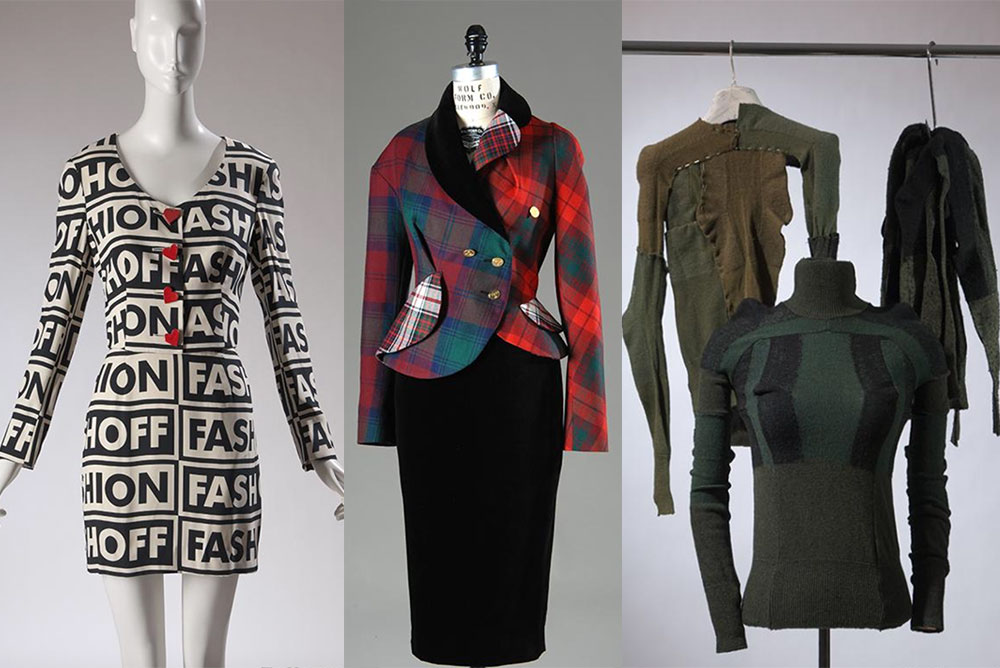
Left: Franco Moschino used humor and incongruous imagery to make philosophical points. On this 1992 suit, Moschino seems to question fashion itself, with graphic lettering that reads “fashion” and “fashoff.” Center: This Fall 1996 suit from Vivienne Westwood incorporates elements of the designer’s fascination with traditional British dress, specifically in its precise tailoring and use of tartan fabric. She irreverently combines these elements with asymmetrical design and mixes tartans to create a suit that reflects her creativity. Right: Deconstructionist Martin Margiela’s 1999 pullover sweater (center) with a mock turtleneck made from knit socks. / Photos courtesy of the Museum at FIT.
Minimalism. Retro. Deconstruction. The rejuvenation of haute couture—these are just a few of the ideas that defined 1990s fashion. FIT’s “Reinvention and Restlessness: Fashion in the Nineties” (through April 17, 2022) features more than 75 looks of designers —Alexander McQueen, Vivienne Westwood, Helmut Lang, Maison Martin Margiela and Prada—who challenged the expected appearance of high fashion, and who laid the foundation for fashion of the 21st century. Through April 17 at the Museum at FIT.
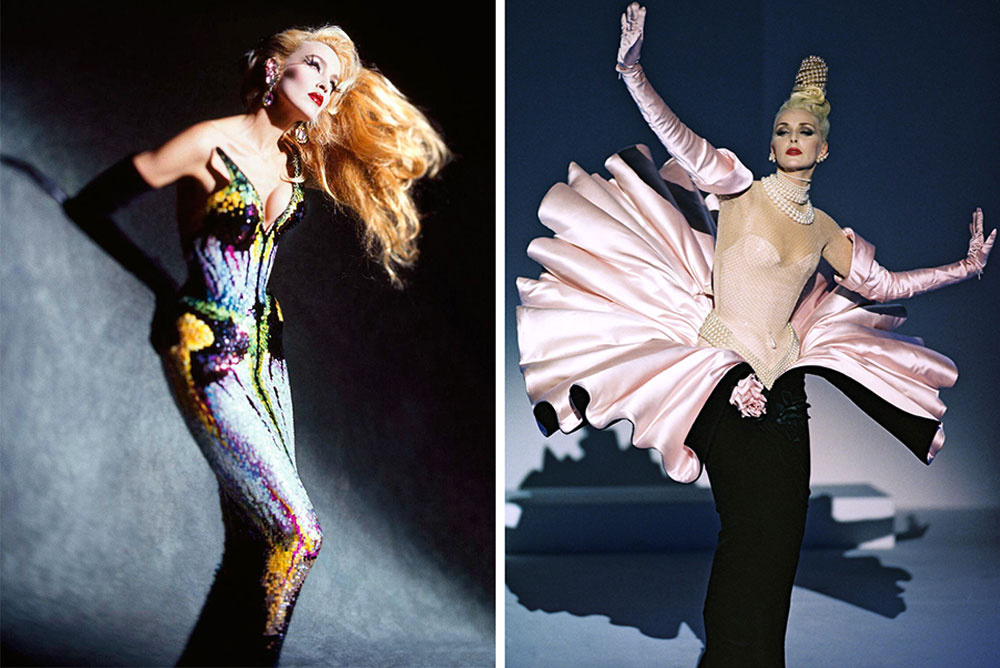
Left: Jerry Hall, Les Insectes collection, Thierry Mugler Haute Couture spring/summer 1997.© Dominique Issermann. Right: A satin scallop shell frames a champagne sequin bodysuit in Mugler’s Haute Couture fall/winter 1996 collection.© Patrice Stable / Photos courtesy of the Musée des Arts Décoratifs.
“Thierry Mugler, Couturissime, which runs through April 24 at the Musée Des Arts Décoratifs in Paris, celebrates the daring fashion designer’s haute couture collections and collaborations with artists and musicians. Born Manfred Thierry Mugler in Strasbourg, France, he studied dance as a teenager before moving to Paris and starting his own brand.
More than 150 of his pieces designed from 1973 to 2014 are in this exhibit, along with photography (he shot his brand’s advertising for years), perfumes (notably his best-selling, Angel) and music videos (he directed George Michael’s “Too Funky”). The exhibition’s opening rooms, devoted to Mr. Mugler’s late 1990s collections “Les Insectes” and “Chimère,” have video backdrops of bucolic and ocean scenes, with sounds of chirping birds and gurgling water. The show also explores recurrent themes in Mugler’s work, such as classic cars and motorcycles—reflected in fender bustiers, radiator belts and a black rubber skirt suit. Futurism is represented by metal and plexiglas corsets and catsuits. Throughout are photographs of Thierry Mugler fashion, taken by Mugler as well as by Guy Bourdin, Jean-Paul Goude, Karl Lagerfeld, Dominique Issermann and David LaChapelle.
Mugler died this January at the age of 73. He left the fashion biz completely in 2002 but then had something of renaissance when he dressed Cardi B for the 2019 Grammys in a look from his Haute Couture Fall/Winter 1995-1996 collection. He also designed Kim Kardashian’s latex beaded gown for the 2019 Met Gala.
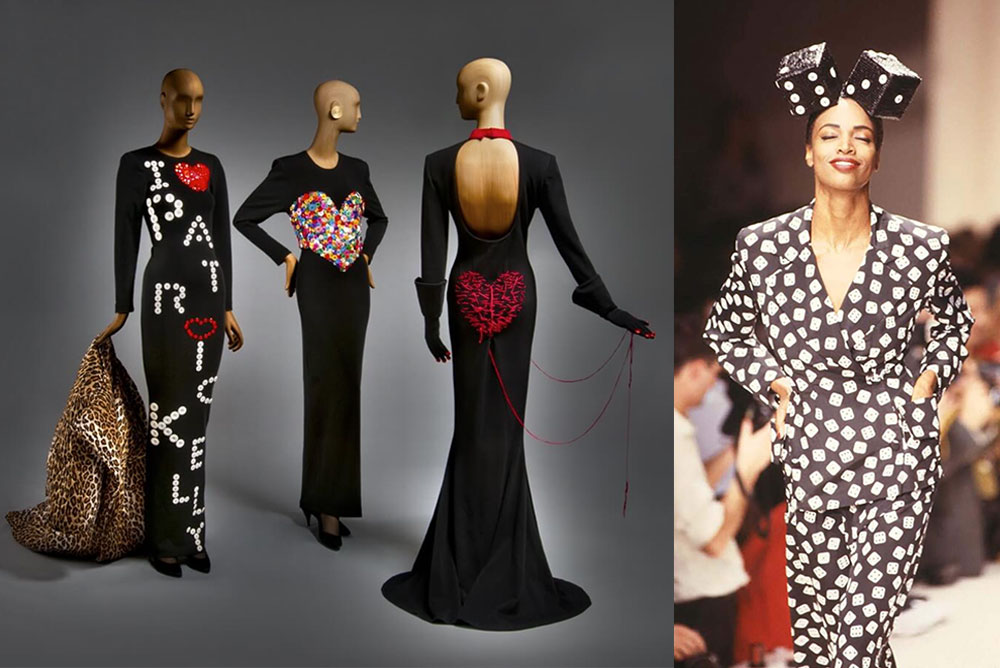
Left: Three dresses by Patrick Kelly, left and center from his fall/winter 1986 collection; right from his, fall/winter 1988 collection. / Image courtesy of the Philadelphia Museum of Art. Right: A model smiles as she walks the runway at Patrick Kelly’s spring/summer 1989 fashion show. Photo by Victor Virgile/Gamma-Rapho via Getty Images. Image courtesy of the Fine Arts Museums of San FranciscoPhoto by Victor VIRGILE/Gamma-Rapho via Getty Images. /Image courtesy of the Fine Arts Museums of San Francisco.
“Patrick Kelly: Runway of Love,” first shown at the Philadelphia Museum of Art in 2014, was rejiggered by the de Young, Fine Arts Museums of San Francisco in 2021, where it runs through April 24. Kelly, who was born in Vicksburg, Mississippi in 1954, was inspired by his Southern upbringing, African-American heritage and his days in New York and Paris, where he was based beginning in 1979. The exhibit, which includes more than 80 runway ensembles, dating from 1984 to 1990, is divided into several themes. “Runway of Love” highlights the designer’s heart-shaped embellishments to his clothing, often composed from his signature buttons. As a child growing up in Vicksburg, Kelly would often lose his buttons, which his grandmother replaced with multicolored ones, a look that Kelly later adapted for his fashion designs. “Mississippi in Paris” takes on Kelly’s experience with racism. He reappropriated images of racial stereotypes—on advertising and household products —for his designs and brand, believing it was necessary to know one’s history to move on. “Hot Couture” is Kelly’s tribute to his muses and fashion history. Madame Grès’ mastery draping and manipulating fabric into Greek goddess-like gowns inspired Kelly’s more practical knitted jersey dresses with wraps that tied around the body.
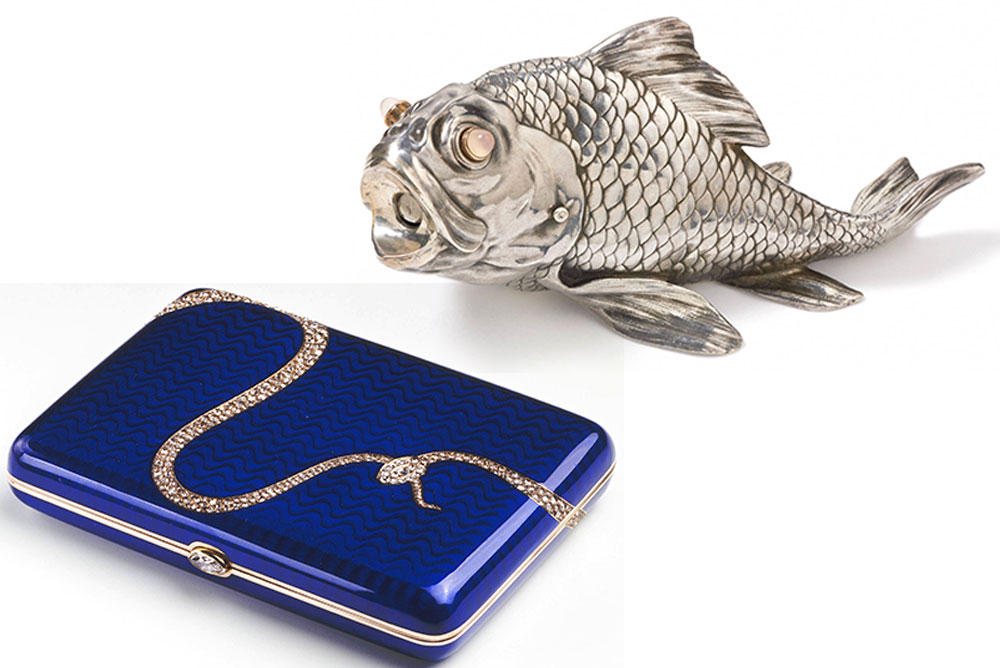
In the foreground: a cigarette case with diamond snake, a gift to Edward VII from his mistress Mrs. Keppel. Cigarette case, by Fabergé, 1908. Royal Collection Trust © Her Majesty Queen Elizabeth II 2021. Above: Silver cigar cutter, modelled as a carp, made by chief Workmaster Henrik Wigstrom for Fabergé, about 1908, St Petersburg. © Courtesy of the Woolf Family and Wartski, London.
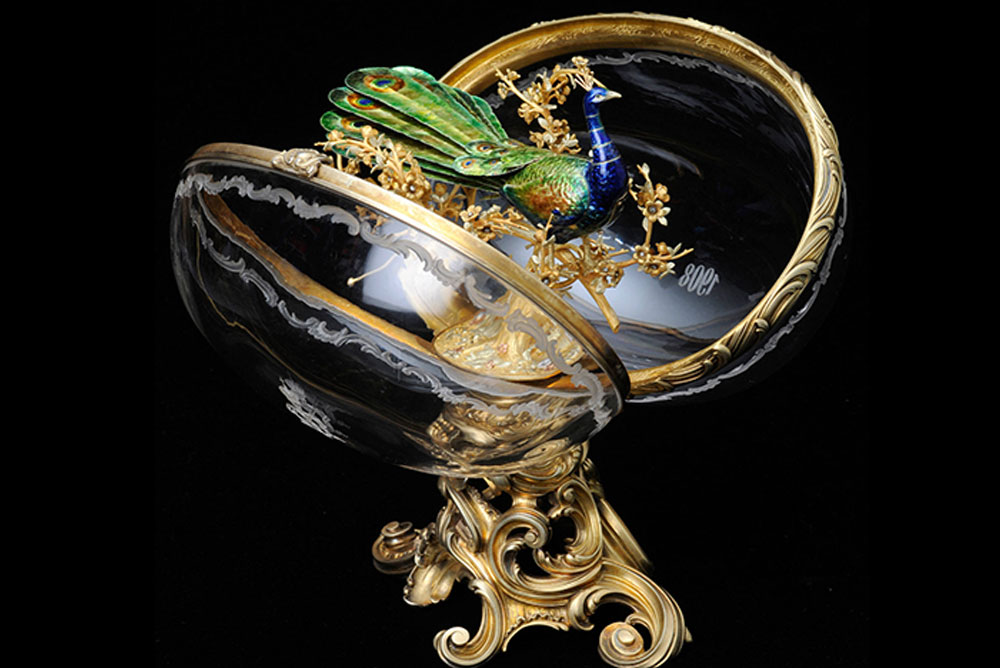
Peacock Egg presented by Emperor Nicholas II to Dowager Empress Maria Feodorovna in Easter 1908, made by chief workmaster Henrik Wigstrom for Fabergé, 1907 – 1908, St Petersburg. / Photos courtesy of the V&A Museum.
“Fabergé in London: Romance to Revolution” is a major show at the V&A (through May 8) devoted to the international prominence of the master Russian goldsmith Carl Fabergé and the importance of his little-known London branch, which opened in 1903 and closed in 1917, as the Revolution hit his Russian workshops. Focusing on Fabergé’s Edwardian high society clientele, the exhibit highlights his success in Britain as well as the global fascination with his creations. Best known for his ornate, very expensive eggs, Fabergé also made many other equally luxurious works during his time, including opulent cigarette cases, a cigar box, set with a sepia enameled view of the Houses of Parliament and a silver cigar cutter in the form of a fish.
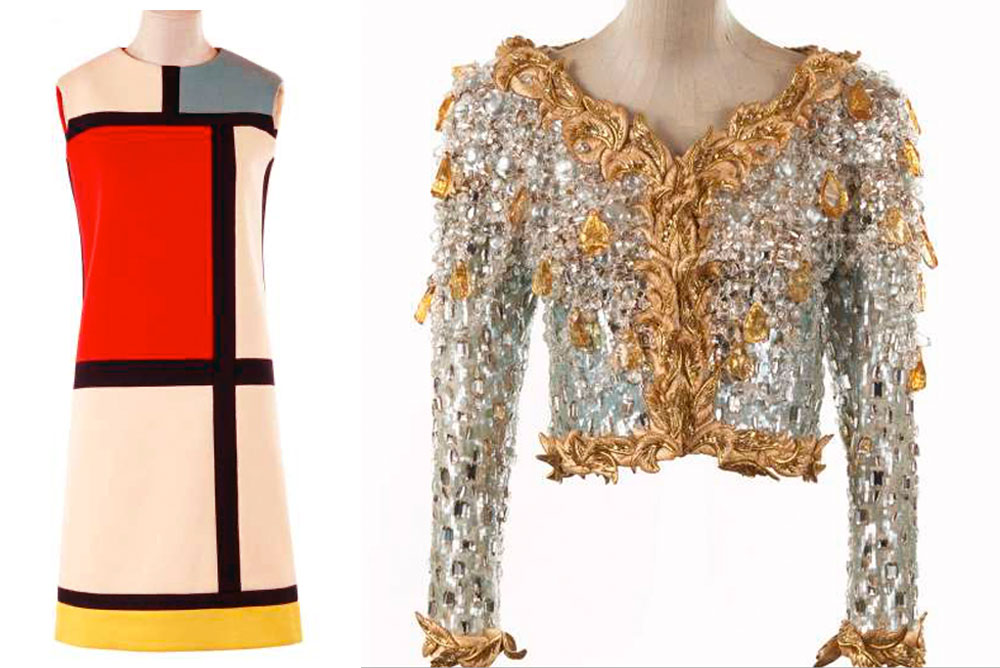
Left: Yves Saint Laurent’s Piet Mondrian black, red, yellow and blue jersey dress from his fall-winter collection of 1965. / Photo courtesy of the Pompidou Center. Right: Organdy jacket embroidered with gold and crystals from Saint Laurent’s spring/summer 1990 collection. / Photo courtesy of the Louvre Museum.
Fashion brand Yves Saint Laurent is celebrating the 60th anniversary of its first show in six of Paris’s mightiest institutions. “Yves Saint Laurent Aux Musées” is shown in exhibits at the Louvre, Musée d’Orsay, Pompidou Centre, Museum of Modern Art, Picasso Museum and Yves Saint Laurent Museum.
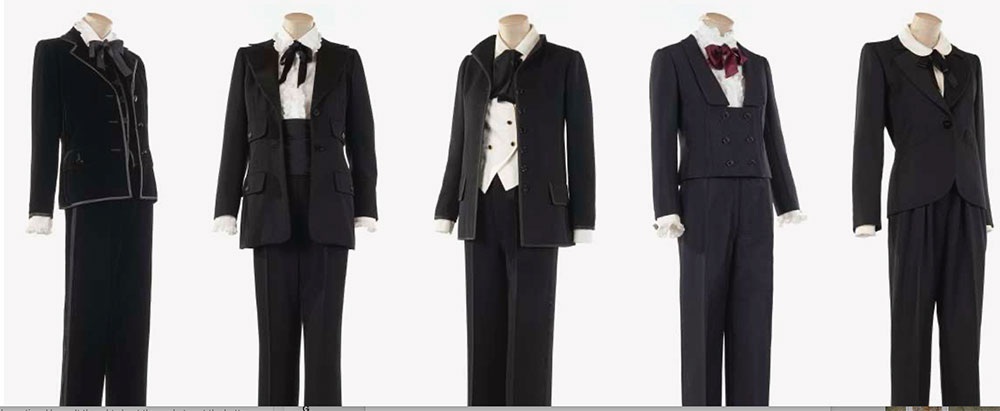
Saint Laurent’s famous “Le Smoking” from left to right, fall 2001, fall 1996, spring 1967, spring 1967 and fall 1988. / Photo courtesy of Musée d’Orsay.
The fact that six museums are paying tribute to him shows how influential he was and highlight the artistic value of his work. But also, each museum will have a different focus and theme. The Louvre, for instance, highlights his love of gold, while the Pompidou focuses on his modern sensibility. The Picasso Museum looks at the influence of you-know-who on YSL’s garments, while the Musée d’Orsay examines the influence of writer Marcel Proust. The Museum of Modern Art’s exhibition sets its sights on YSL’s use of color.
Entry costs vary by museum, and while all exhibitions will run until May 15, some are on for longer than others. Check each museum’s website for more information.
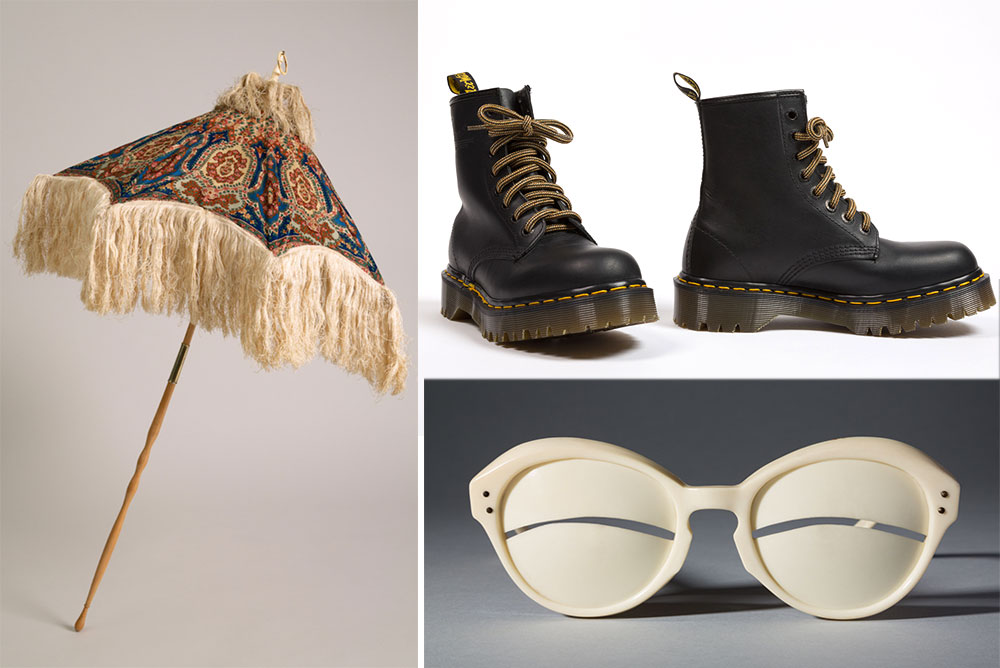
Left: Silk and wood parasol, 1860s. Above right: Dr. Martens, work boots, 2000. Below right: Ivory plastic sunglasses, André Courrèges, spring/summer 1965./ Photos courtesy of the Museum at FIT.
“HEAD TO TOE”, a Museum at the Fashion Institute of Technology exhibition, explores approximately 200 years of women’s dress from 1800 to the early 21st century through the lens of accessories. The show, with 30 garments and more than 200 accessories, is organized chronologically to illustrate the evolution of Western women’s fashion over two centuries.
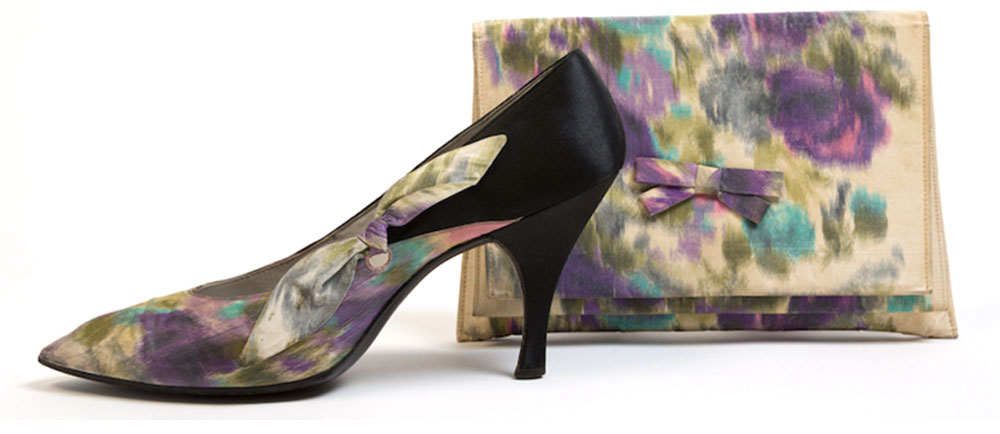
Roger Vivier for Christian Dior, evening pumps and purse, 1955-1959. / Photo courtesy of the Museum at FIT.
Today, a pair of high-end designer sunglasses has superseded the luxurious parasol of the nineteenth century, yet both convey aspirational status as they shade their wearers. Likewise, a designer cell phone case may have replaced a bejeweled makeup compact of the twenties, but both speak to modernity and progress in a continually changing world.
Christian Dior, Cristóbal Balenciaga, Fendi, Pierre Balmain, Roger Viver, Lilly Daché, Claire McCardell, Tréfousse, Judith Leiber and André Courréges are some of the featured designers. The exhibition runs through May 15.
BEGINNING May 7, the Metropolitan Museum of Art’s Costume Institute will open the second part of a two-part exhibit about fashion in the United States. In America: An Anthology of Fashion, which will run through September 5, is presented in collaboration with the museum’s American Wing.
Men’s and women’s dress from the eighteenth century to the present will be featured in vignettes in select American Wing period rooms spanning from about 1805 to 1915, including a Shaker Retiring Room from the 1830s; a 19th-century parlor from Richmond, Virginia; and a 20th-century living room designed by Frank Lloyd Wright. These interiors will tell a tale of more than 200 years of American domestic life. Through a series of three-dimensional cinematic “freeze frames,” produced with the cooperation of notable American film directors, the exhibition will reflect on the role of dress in shaping American identity.

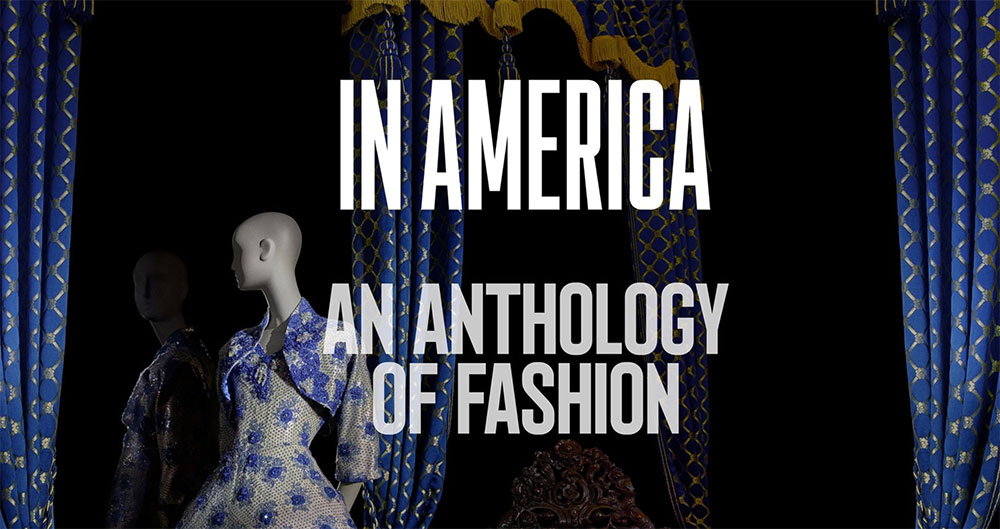

Let’s go to anything in the US!! I love these exhibits.